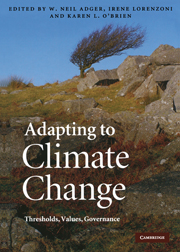Book contents
- Frontmatter
- Contents
- List of contributors
- Preface
- 1 Adaptation now
- Part I Adapting to thresholds in physical and ecological systems
- 2 Ecological limits of adaptation to climate change
- 3 Adapting to the effects of climate change on water supply reliability
- 4 Protecting London from tidal flooding: limits to engineering adaptation
- 5 Climate prediction: a limit to adaptation?
- 6 Learning to crawl: how to use seasonal climate forecasts to build adaptive capacity
- 7 Norse Greenland settlement and limits to adaptation
- 8 Sea ice change in Arctic Canada: are there limits to Inuit adaptation?
- Part II The role of values and culture in adaptation
- Part III Governance, knowledge and technologies for adaptation
- 31 Conclusions: Transforming the world
- Index
- References
3 - Adapting to the effects of climate change on water supply reliability
Published online by Cambridge University Press: 31 August 2009
- Frontmatter
- Contents
- List of contributors
- Preface
- 1 Adaptation now
- Part I Adapting to thresholds in physical and ecological systems
- 2 Ecological limits of adaptation to climate change
- 3 Adapting to the effects of climate change on water supply reliability
- 4 Protecting London from tidal flooding: limits to engineering adaptation
- 5 Climate prediction: a limit to adaptation?
- 6 Learning to crawl: how to use seasonal climate forecasts to build adaptive capacity
- 7 Norse Greenland settlement and limits to adaptation
- 8 Sea ice change in Arctic Canada: are there limits to Inuit adaptation?
- Part II The role of values and culture in adaptation
- Part III Governance, knowledge and technologies for adaptation
- 31 Conclusions: Transforming the world
- Index
- References
Summary
Introduction
Climate change is expected to produce higher temperatures, drier summers and wetter winters across southern England. Reductions in water availability are expected as a consequence (Arnell, 2004) with direct abstractions becoming less reliable during summer and more seasonal, higher intensity rainfall producing high runoff and less water able to percolate into aquifers (Environment Agency, 2005). In an area already facing water deficits and supply challenges (Environment Agency, 2007a), and with increasing population demands, adaptation in the short term (to 2030) is necessary. With water resources in south-east England under increasing pressure, water companies and their regulators are exploring options to adapt not only to altered demands, but also to the challenge of climate change. The water supply industry in England and Wales is well aware of the challenge of climate change, and methodologies exist to both estimate the effects of climate change and support adaptation decisions (Arnell and Delaney, 2006). The industry has also identified a wide range of options for addressing the supply–demand imbalance, covering both supply-side and demand-side measures.
However, there are specific barriers to the implementation of each option, and some generic constraints on the ability of water supply companies to adapt to a changing climate. This chapter presents preliminary results from an assessment of the barriers to adaptation to water supply shortage in a case study catchment in south-east England with multiple supply companies.
- Type
- Chapter
- Information
- Adapting to Climate ChangeThresholds, Values, Governance, pp. 42 - 53Publisher: Cambridge University PressPrint publication year: 2009
References
- 7
- Cited by



